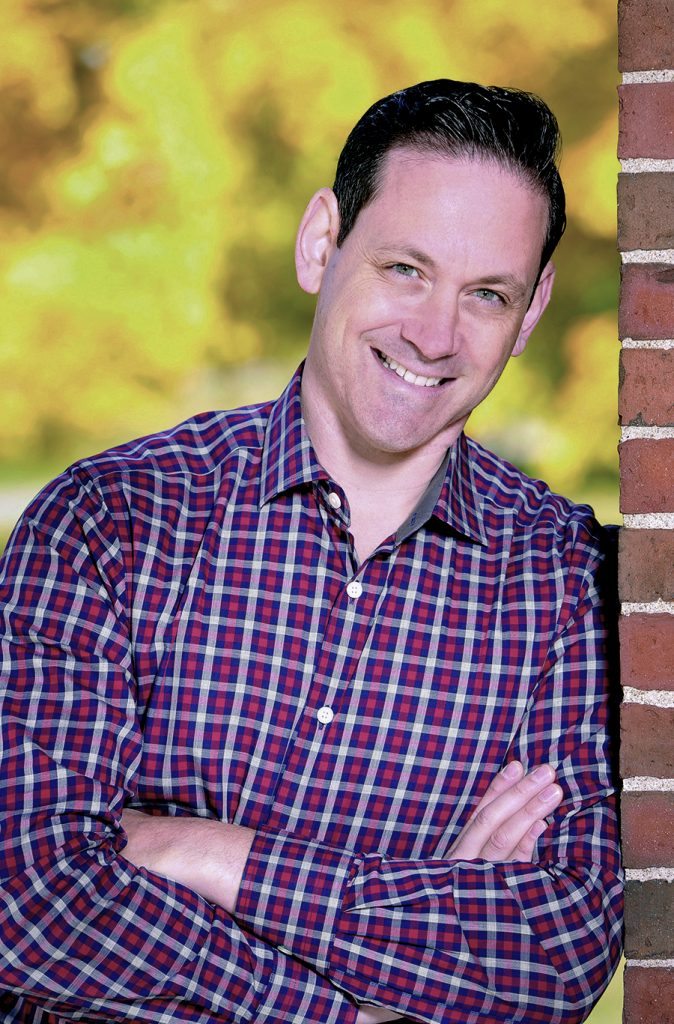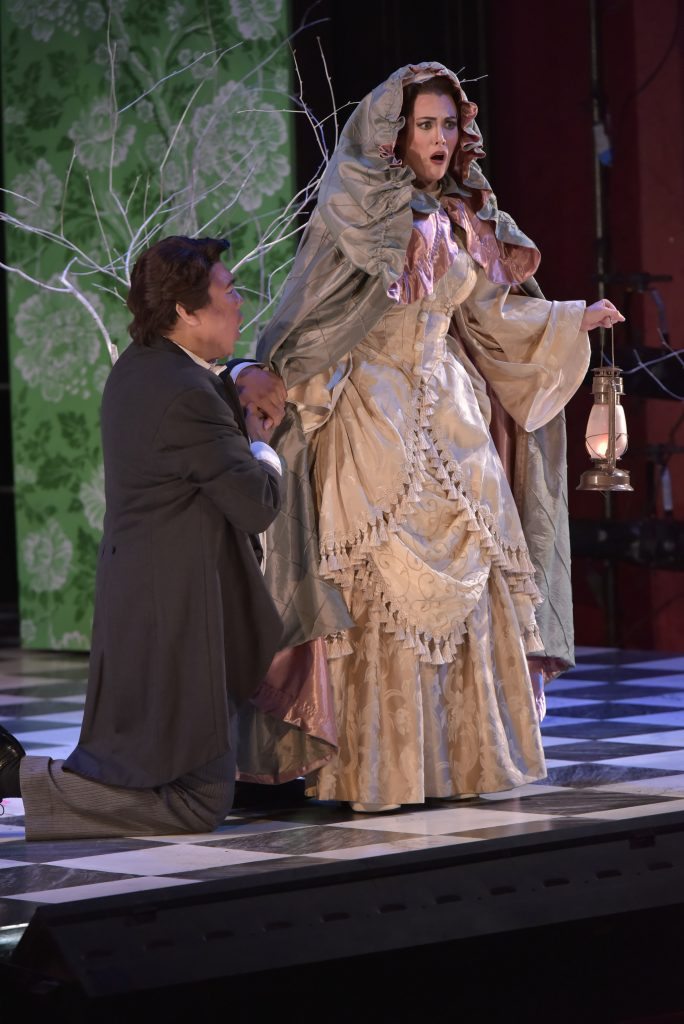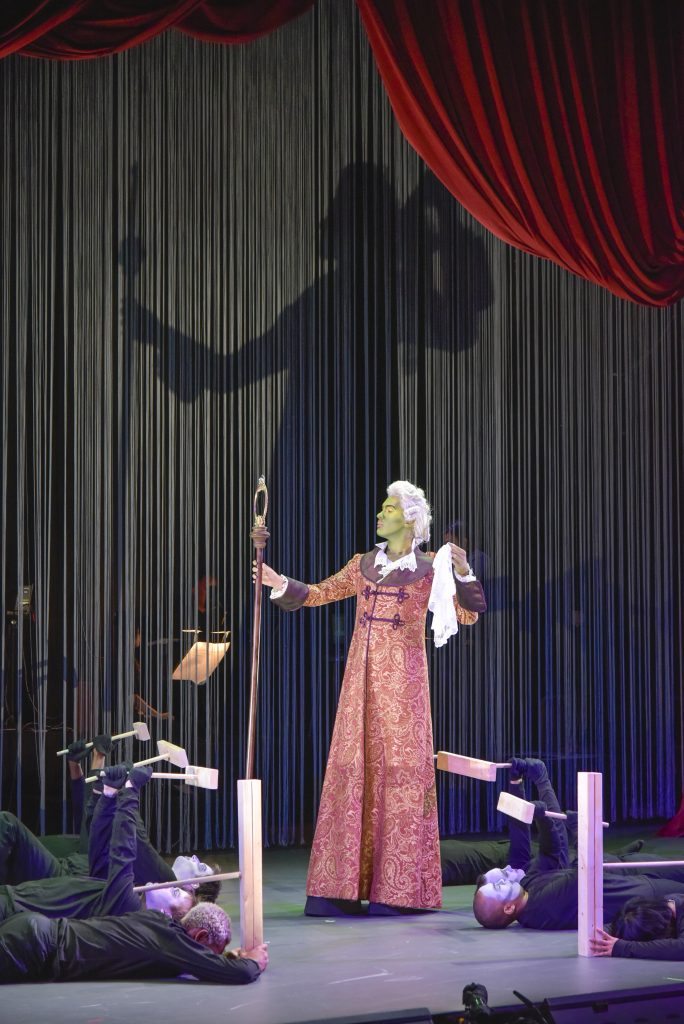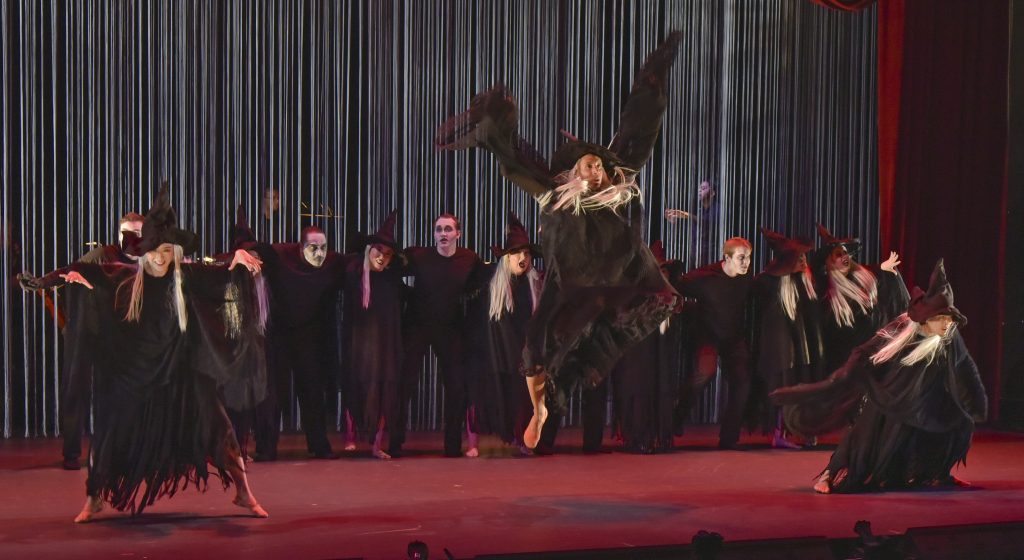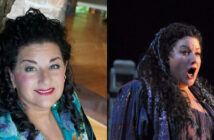Nestled in the Adirondack foothills near the headstreams of the Hudson River, the City of Saratoga Springs in upstate New York was once the dowager empress of America’s great Victorian-era summer resorts, its fame resting on an abundance of fresh, natural mineral springs bubbling up from faults far below the earth’s surface, and alleged to possess restorative powers.
Those magical waters still flow from the city’s protected aquifer today; but in a recreational economy that long ago diversified beyond mineral spas – racetrack, casino, restaurants and contending cultural attractions – one ought not overlook another local font whose output springs every bit as serendipitous and vibrant each season: the annual gusher of glorious music from Opera Saratoga.
The company boasts a pedigree stretching back 54 years, to the 1962 formation of Lake George Opera, originally headquartered some 30 miles north. By institutional continuity, then, the company’s present incarnation is arguably one of the oldest abiding opera producing enterprises of its size and regional provenance in the country.
But by another measure, Opera Saratoga might be considered rather younger. It moved into its current permanent home at Saratoga Spa State Park in 1998, and only adopted the Opera Saratoga name in 2011. Indeed, by yet another measure, the company might be considered doubly young – even born again – with the appointment just two seasons ago of its ambitious and energetic new artistic and general director, Lawrence Edelson.
Glancing Back, Looking Ahead
Edelson is a youthful, infectiously upbeat man-for-all-challenges where the arts are concerned. He is a director; he is also a trained vocalist and dancer, an accomplished arts administrator and promoter, and a maverick innovator of contemporary stratagems for making the classics matter (his NYU master’s thesis was mischievously entitled “Opera: The Irrelevant Art,” which one can safely assume actually adumbrated a virtual manifesto of techniques for the reclamation of that relevance).
In a welcoming note published for this season’s opener – a new production of Mozart’s frothy, naughty farce Le Nozze di Figaro – Edelson points out that 2016 marks 20 years exactly since this opera last played the company’s stage. A nifty nugget of trivia, sure. But the observation also speaks subtly and tellingly to Edelson’s approach to his job – a significant little nod to the past by the man charged with steering the company into its future.
“I made a conscious decision to look forward and backward at the same time,” Edelson says of his appointment. “To look at the history of the organization, to understand where the core of the company came from, so that we could build on what had been most successful.”
In particular, Edelson has looked for inspiration and instruction to the era from 1965 to 1980, when the company was headed by the late, legendary tenor and opera educator David Lloyd (who later directed the American Opera Center at the Juilliard School).
“David Lloyd was the one who really professionalized the company,” Edelson says of Lloyd’s achievements in enlarging the orchestra, committing to an expanded repertory that included works by Britten, Floyd, and Moore, presenting four world premieres and, all told, overseeing more than 70 productions of more than 50 different works during his time leading the company.
Since Lloyd’s day, of course, “opera has become more and more expensive to produce,” observes Edelson. Plus, more recently, “there was a recession, which caused a lot of companies to downsize in order to survive, drastically cutting back their programming. A number of other companies closed altogether.”
Nonetheless, at Opera Saratoga, Edelson says he has “tried to help facilitate the expansion of our programming,” harking back, again, to the Lloyd days, “when the company was most active.” Indeed, Edelson has already scored a major accomplishment, beefing up the Opera Saratoga calendar to three fully produced operas per season in his first two years, a hike from the prior recent norm of just two.
And not skimping at it. “It’s important to invest money in the product,” Edelson says. “You can’t just save your way to success.” In fact, the company now has an approximately $1.25 million annual capitalization, making it an Opera America Level 3 company, up from a Level 4 (below $1 million in capitalization) at the time of Edelson’s appointment.
And the approach appears to be working, with a 35% increase in ticket sales this season, and the best performance year since before the recession.
A New Figaro
This season’s new take on Nozze di Figaro and its amorous hijinks in and around Count Almaviva’s Spanish country estate (called Aguas-Frescas in the libretto; how’s that for a production at Saratoga?) saw the action spun out dizzyingly and masterfully by director David Paul and his cast, and orchestral conductor Andrew Bisantz. (Performances were June 24 and 27 and July 9 and 15; viewed on June 24.)
Performances were uniformly engaging and accomplished. Sopranos Chelsea Basler as the lady’s maid, Susanna, and Katherine Whyte as her mistress, the Countess Almaviva, were both splendid. Basler gave us a sassy soubrette of earthy peasant good sense and rich, sensual vocalism. Whyte offered refinement, elegance and lambent expressiveness, notably in her delicately excruciating lament, “Porgi, amor.” Baritone Keith Phares managed the difficult task of actually making the lecherous Count sympathetic – for once, we don’t feel cheated that the character evades an infernal Don-Giovanni-like comeuppance; we root for his redemption, sensing him more a victim of the cult of machismo than a congenital cad, and are pleased by his return to sanity and fidelity. Lead bass Peixin Chen, as the eponymous Figaro, provided a rich-toned and solid-bodied protagonist, his physical formidability belying the character’s nimble and mercurial antics, yet capturing the latter so effectively as to make his performance a constant surprise and delight.
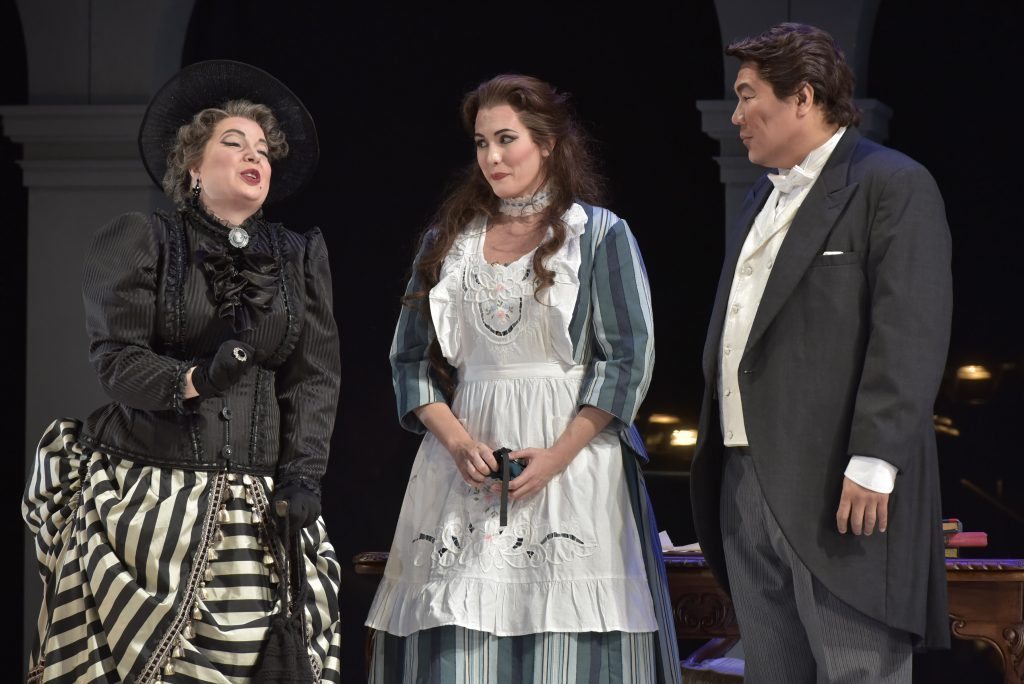
Clara Neiman (Marcellina), Chelsea Basler (Susanna), and Peixin Chen (Figaro), Le Nozze di Figaro, Photo: Gary David Gold
A Diverse Repertory
Providing striking contrast to the Mozart romp, a second offering of the 2016 season was the late composer Daniel Catán’s masterful final work, Il Postino.
“I firmly believe in diverse repertory that includes new American works,” Edelson says. “I think every American opera company has a responsibility to produce such works.” And Edelson is in a good position to make that happen at Saratoga. Besides his duties with the opera company, Edelson is the founder of the American Lyric Theater (ALT), an incubator committed to the mentorship of composers and librettists working on creating promising new operatic works.
One of the many reasons the Opera Saratoga board was interested in his candidacy, Edelson says, was the prospect of creating an avenue between the company in Saratoga and the works developed at ALT. An example of such cross-pollination occurred as early as Edelson’s first summer season in 2015, with Opera Saratoga’s premiere of The Long Walk by composer Jeremy Howard Beck and librettist Stephanie Fleischmann. Developed at ALT, the opera dealt with an Iraq War veteran’s return from conflict and his traumatic attempts to renew relations with his wife and reintegrate into civilian life. And, though he is not at liberty to discuss details, it appears likely that 2018 will bring another important work being created by artists associated with ALT to the Opera Saratoga stage.
The Postman Cometh
Edelson himself directed this season’s production of Catán’s Il Postino, and it’s a poignant tribute, since Catán was a colleague of Edelson’s at ALT before his death in 2011.
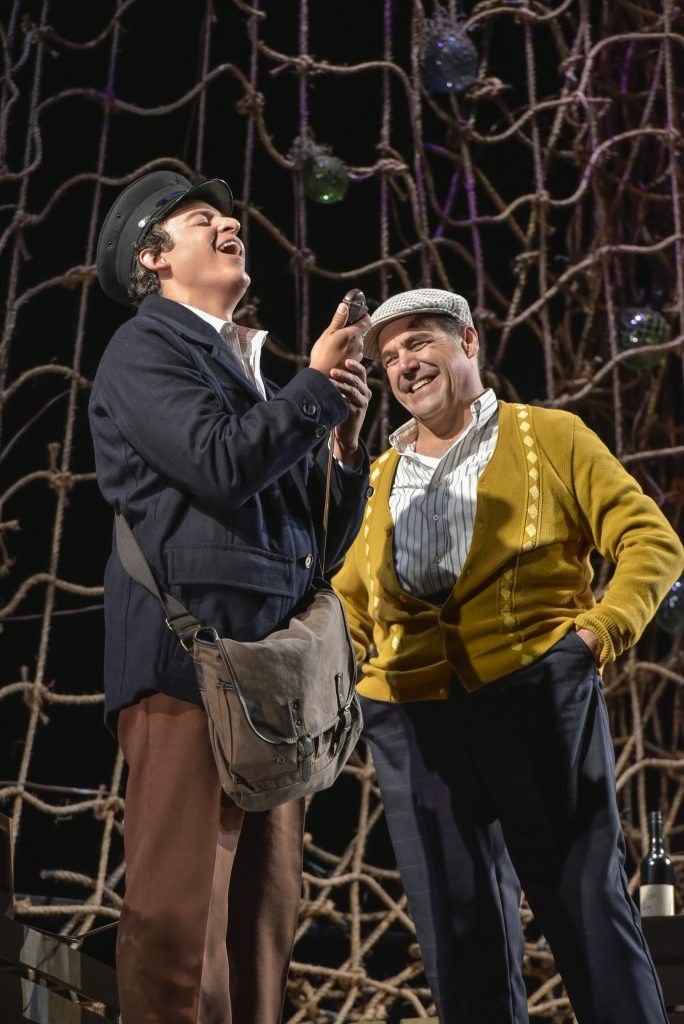
Daniel Montenegro (Mario Ruoppolo) and Richard Troxell (Pablo Neruda), Il Postino, Photo: Gary David Gold
Based on the Antonio Skármeta novel, and the celebrated 1994 Michael Radford/Massimo Troisi film, Il Postino tells the fictionalized story of famed Chilean poet and political activist Pablo Neruda’s sojourn of exile on a small Italian island, and the close, almost paternal relationship Neruda forms with a sensitive young misfit postman, Mario Ruoppolo. The libretto, also by Catán, is entirely in Spanish. (Performances were July 7, 10 and 16; viewed on July 16.)
Catán’s resourceful, lush score is exquisite, the first act restless and shimmering with delicate intertwining lines that create, apropos the sea-dominated setting of the story, a constant, tide-like shifting of tonal centers; the second act by contrast throbs with mounting erotic fervor as Mario deploys Neruda’s poetry to win the woman he desires; and the surprising dramatic turns of the third act are reflected in equally unanticipated and exhilarating excursions into ravishing, Puccini-like waves of emotion.
The heart of the opera is the relationship of the two tenor leads, and authentic chemistry between them is obligatory. Such was in ample supply between Richard Troxell’s wonderfully seasoned and ironic Neruda (a role originated by Placido Domingo) and Daniel Montenegro’s touchingly diffident, awkward, puppy-clumsy Mario. The two performers negotiated with thrilling musicality their several set pieces, culminating with a heart-rending finale that merged Troxell’s mature lyric sound with Montenegro’s uniquely youthful spinto in a remarkable tenor duet surely unparalleled in the literature, and impossible to forget. The women in these men’s lives were performed with ardor, honesty, and supple allure by Sandra López and Cecilia Violetta López. Edelson’s flawless direction was brilliantly abetted by conductor James Lowe’s illumination of the coruscating score.
A Summer Place
Summer opera-goers are fortunate indeed to take in a work like Il Postino – or any of the season’s offerings – in so genial and de-stressed an environment as Saratoga in June and July. In fact, Saratoga’s casual atmospherics are an asset Edelson has seized on in his bid to regenerate operatic relevance.
“Over many decades,” Edelson says, “Americans have created artificial codes of behavior surrounding opera that have made audiences feel unnecessarily formal.” Edelson is bent on dismantling that distancing formality.
And he leads by example. At Opera Saratoga performances, Edelson seems to be everywhere: greeting patrons in the lobby beforehand, bounding onstage to make charming curtain speeches, shaking hands at post-performance gatherings on the colonnaded loggia behind the theater, sometimes casual in shirtsleeves, other times dapper and duded in a natty summer seersucker suit. And Edelson’s supporting players – box office staff, ushers, concession stand volunteers – all contribute to the homey feeling, too. Arriving at an Opera Saratoga performance is much like attending a county fair or a block party – neighborly, welcoming, down-home, American.
The theater in which Opera Saratoga performs – the intimate 500-seat neo-Georgian “Spa Little Theater” – is also well-suited to this program of scaling the opera experience toward the popular, the accessible, the human. There isn’t an orchestra pit. Thus, conductor and instrumentalists are placed onstage, integrated into a production’s set design; and audiences experience the action up-close and direct, unmediated by any orchestral moat (while discreetly placed closed-circuit monitors mounted in the house, facing the stage, allow performers to steal the occasional glance at the conductor, if needed). Far from a handicap, such logistics might rouse many a canny composer – Mozart springs to mind – to applause.
Then, there’s the larger setting. The Spa Little Theater is itself part of a vast campus of greenspace and Palladian architecture known as New York’s Saratoga Spa State Park. Built by the State in the 1930s to showcase the then newly-conserved major natural wellsprings, with sprawling vistas of lawn traversed by arch-studded covered walkways, reflecting pools, promenades, and handsome neoclassic bath-house buildings, it’s a landscape that might have sprung from a painted operatic backdrop – a daydream of Arcadia where satyrs and nymphs might consort. (Indeed, the mythic was given free range amidst this setting during Edelson’s first season, with the 2015 plein-air production of Purcell’s Dido and Aeneas.)
Glass’ Bumps in the Night
Ah, but what of a dark side? Surely, not all in Saratoga is done by daylight, nor in the strains of wholesome classic idyll. No, indeed. Which brings us to the third of Opera Saratoga’s Summer 2016 attractions.
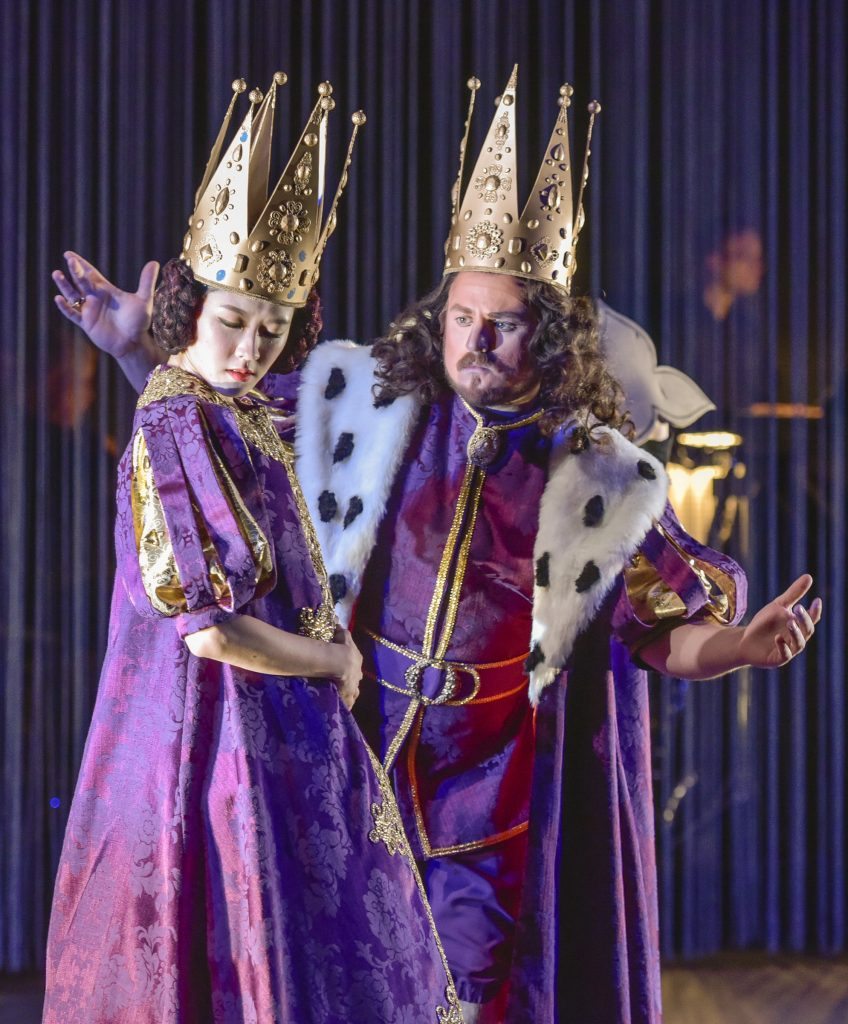
Dominick Corbacio and Chanmee Jeong (The King and Queen of Venice), The Witches of Venice, Photo: Gary David Gold
Despite its predominantly leisure-time cachet, a certain aura of the mystic and the supernatural has seemingly always haunted Saratoga (Native Americans are said to have accorded cautious reverence to the place, and Gilded-Age ghosts still regularly surprise tourists at Canfield Casino or peer down at diners from the upper floors at Olde Bryan Inn). Thus it may have been that, in commune with this veritable Saratoga of the Shadows, Opera Saratoga brewed up its most bruited succès de scandale of the summer 2016 season – a flamboyant and full-out staging of the 1995 Philip Glass rarity, The Witches of Venice (le Streghe di Venezia), with a libretto by the late Italian designer, director and author Beni Montresor, from his earlier children’s book and accompanying phantasmagoric, Maurice Sendak-like illustrations. (Performances were July 2, 11 and 17; viewed on July 17.)
Billed as a “children’s opera-ballet,” this madcap, genre-busting spectacle is sustained not by narrative or character, but by sheer dream logic, plus one of Glass’ trademark, irresistibly propulsive scores. By turns terrifying, enigmatic, poignant, and wheezily aerobic (marketing idea: The Venetian Witches’ Workout DVD!), this 70-minute tour-de-force suggested at times the theatricality of old-timey, impresario-driven extravaganzas like The Black Crook!; at others, a Renaissance masque; at others still, the ritual brutality of kabuki; and, at its most hallucinatory, perhaps even the limbic-tickling transports that may have visited ancient-world initiates into the mysteries of Mithras. (One particularly scary dance sequence for a trio of witches could have been transposed whole into Glass’ 1999 score for the classic Dracula film, composed for performance by the Kronos Quartet.)
With a cast of over 50 – more than 20 of them local children – the Spa Little Theater fairly burst at the seams with witches and their adjunct choruses of ghosts, skeletons, fairies and enchanted plant-life vivant. The costumes were jaw-droppingly elaborate (indeed, costumes were the principal decor of the piece, and the company gratefully acknowledges a generous grant from the Alfred Z. Solomon Charitable Trust, which underwrote designer Martin T. Lopez’s creations for both Witches and Il Postino).
But what does it all mean, this tale of a childless royal couple in some mythic ancient Venice, persuaded to grow a boy-heir in their enchanted garden? Who knows? Who cares! It sufficeth to savor each discrete and garish sequent delight, like the projected supertitle reading “Down a hall, a narcissistic ogre admires himself lovingly…” as a shocking, periwigged, seven-foot courtier glides onto the stage, brandishing a long-handled mirror, a baleful time traveler replete with selfie stick.
Special mention should be made of dancers Randall Smith, Kira Petersen, and Yusaku Komori for their lithe gracefulness and athletic endurance; and the juvenile lead players Oliver Nathanielsz (with a mournful and gorgeous Westminster Boys’ Choir-style voice) and Akhila Venkat (a young ballerina of poise and promise). And one can but envy the theatrical ur-memories laid down for all the children who participated in this astonishing, eccentric, infectiously exuberant experience. If they are not forever stage-struck in the wake of internalizing Glass’ complex rhythms (coolly and precisely conducted by Viswa Subbaraman and performed by the indefatigable chamber ensemble), mastering the structured wildness of the elaborate choreography (by director Karole Armitage, who also created the 2015 Dido), negotiating the intoxicating mayhem that must have obtained backstage amidst designer Lopez’ acres of costumes, then there is no theater bug left anywhere with any bite.
A Commitment to Young Artists
All the principal singing roles in The Witches of Venice – as well as all the comprimario roles, some of the principal roles and all principal understudy duties in the other two productions of the summer – were performed by members of Opera Saratoga’s impressive Young Artists Program. These sterling performers also filled out their busy summer headlining numerous promotional concerts and special events sponsored by the company across the community and the region.
“Our Young Artists Program serves to bridge the gap between conservatory and the professional world,” says Edelson, and he and his board have made a hefty and renewed commitment to it – the second oldest program of its kind in the country (after that at Santa Fe Opera) – having virtually doubled its size (there were 23 singers in the 2016 program) as well as adding tiers for two emerging conductors, two emerging directors, and a pianist/coach.
“American opera singers are among the most well-trained and versatile in the world,” Edelson says, “as evidenced by the fact that they are singing everywhere, domestically and internationally.” The 2016 program comprised vocalists with degrees from a top-drawer roster of institutions, including the Juilliard School, the Eastman School, The Manhattan School of Music, Northwestern University, the San Francisco Conservatory, the Boston Conservatory, and NYU. Each program participant was individually sponsored and underwritten by a different Opera Saratoga donor, making personal their fostering of the future for the company and the art form.
An Old Art, a Young Century…
Regarded either as old or new, the Opera Saratoga story is edifying, modeling so clearly as it does all the virtues – and epitomizing all the tantalizing paradoxes and challenges – of comparable 21st-Century companies throughout North America: modestly capitalized undertakings offering attractive and resourceful productions with scrupulously high musical and performance standards; companies affording important training for formative artists as well as crucial sustaining professional opportunities for developing and established talent; companies big of heart, clever of budget, lean of margin, and agile of operation, conversant with the tastes and expectations of their core audiences, yet able to prompt discussion and maybe even occasional controversy, engendering new interest and engaging new support, all while capitalizing on a sometimes diffuse yet palpable pride and sense of ownership among the communities within which they labor.
“I’ve never been disappointed,” says Eleanor, a retired high-school history teacher who has been a subscriber to the company from its inception on Lake George in 1962. “And I think what Larry Edelson is doing is great.”
“If I had one wish,” she continues, “I’d have an angel come down and give this company a million dollars on the spot.” She reflects on that a moment, then adds with a sigh, “Unfortunately, I’m an atheist.”
Things to Come
Looking to next year, the 2017 Opera Saratoga season will include Verdi’s masterful farewell opera, Falstaff, and a new production of Marc Blitzstein’s 1937 The Cradle Will Rock, directed by Edelson himself, conducted by John Mauceri, and featuring the full original orchestrations for the first time anywhere since the 1960 NYCO presentation.
The season will also offer a little-known operatic take on the Beauty and the Beast tale, André Grétry’s Zémire et Azor, claimed to have been a favorite of Mozart’s in his time. The Opera Saratoga production will be handled by first-time operatic director James Ortiz, who in 2015 co-created the sensational off-Broadway riff on the Wizard of Oz, The Woodsman, with his theater company, Strangeman & Co. Ortiz co-directed, performed, and designed the series of beautiful and unique puppets used in that production.
Edelson approached Ortiz about the Grétry opera after attending the off-Broadway show. “When I saw what he had done with The Woodsman, I said to myself ‘this guy has got to do opera.’” And Ortiz has already thrown himself into the challenge with gusto. “I’m dreaming and designing and talking with choreographers, coming up with the world of the opera,” he says. “This is the fun part!”
A Destination
Edelson notes that Saratoga is situated such that it can be a cultural tourism destination for travelers from several vectors, including Montreal and New York (an easy Amtrak ride from either; “and there is car rental available a short distance from the station,” remarks Edelson), as well as Boston. This is one more reason to ensure his repertory is diverse and interesting. “If I’m only producing the same stuff they can see in their resident urban centers – another Carmen, another Barber of Seville – why would they want to come see us?” Edelson mentions with pride that, in each of the last two seasons, the company has enjoyed visits from audience members hailing from more than 40 U.S. states.
Burning bright and hot each summer, and determined to serve the community throughout the year as well, with enhanced adult and children’s educational programming, Edelson and his company are waging a mirthful and all-out campaign on behalf of operatic relevance. In presenting each season as a delicious and witty sampler of the old and new, the canonical and the recondite, not only are they building audiences; they are in effect cultivating connoisseurs by stealth.
Looking to their example, one cannot but celebrate the hope and optimism that, like the reviving waters of Saratoga, spring eternal.


